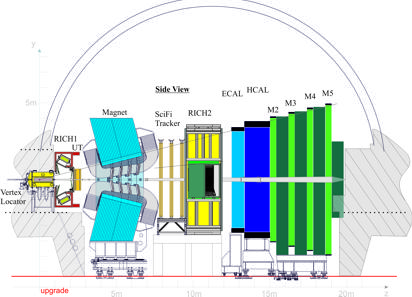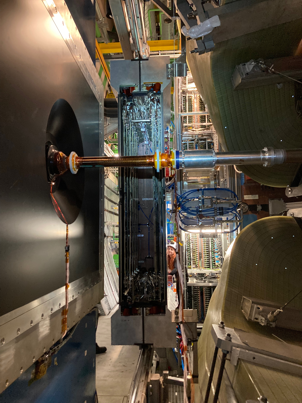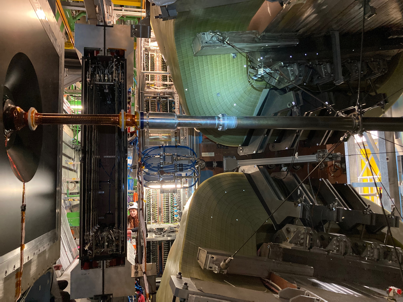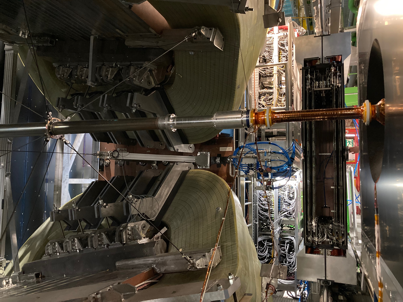Start of 2023 data taking.
Recently the Upstream Tracker (UT), a sub-detector of the LHCb experiment, was closed around the LHC beam pipe. This event marked the completion of the installation of the LHCb Upgrade1 detector.
The UT sub-detector is located in front of the LHCb dipole magnet, as seen in the schema displayed at the left. The images included in this news were taken during the UT closing process around the LHC beam pipe. The UT plays an essential role in achieving the desired processing speed in the innovative LHCb real-time event selection, by providing an estimate of the momentum and charge of the reconstructed tracks. Moreover it significantly reduces the rate of fake tracks created by mismatched hits in the VErtex LOcator (VELO) and SciFi sub-detectors, and is an integral component of the outstanding LHCb tracking system.
The layout of the LHCb experiment differs from traditional ideas of particle physics detectors in which the coordinates of charged particle tracks are measured multiple times inside the magnetic field by a set of tracking chambers. Instead, in LHCb, the volume inside the magnet is empty. The LHCb tracking algorithms compare track segments measured before and after the magnet, and use the measured deflection inside the magnet to define the particle momentum and charge. In addition, the UT, while not inside the magnet, still experiences a small fringe magnetic field. This allows it to make a crucial independent estimate of the particle momentum and charge by comparing its precisely measured points with the track segment in the VELO. These two methods of momentum measurement are critical to allow the real-time trigger to operate with the required speed and robustness. In addition the UT provides reconstruction of particles decaying after the VELO, such as K0 mesons, or hypothetical long lived particles which may be predicted by New Physics models.
In Run 3 the proton-proton collision rate inside the LHCb detector will be five times higher than before and the whole LHCb detector is read out at the proton-proton bunch collision rate of 40 MHz instead of the previous 1 MHz. The UT replaces the (Tracker Turicensis – TT), previously playing a similar role. However, the UT works at Run 3 at much higher data acquisition frequency and with greater particle density from the proton-proton collisions at LHC. Its design is based on 10 cm x 10 cm x 0.25 mm silicon sensors mounted on a lightweight carbon fiber support structure, called a stave. The staves are used to form 4 large planes of silicon. The UT was successfully installed on a very tight schedule during the year end technical stop, working seven days per week and throughout the christmas break.The final connections and closing around the beam-pip were performed in time for the start of the 2023 run. The detector will be commissioned over the next period.
The installation of the UT marks the completion of the new LHCb Upgrade 1 detector. The VErtex LOcator (VELO) has been upgraded and is now based on silicon pixels mounted on microchannel cooled silicon wafers. The tracking detectors have been replaced by the Upstream Tracker (UT) and by the three stations of the Scintillating Fibre Tracker (SciFi), which are placed downstream of the magnet, and consist of 2.5m-long scintillating plastic fibre mats read out by silicon photo-multipliers. The RICH1 is now a brand new sub-detector: the complete optics and mechanics have been re-designed and re-built, the mirrors have a larger radius of curvature, and Hybrid Photon Detectors (HPD) have been replaced by multi-anode photomultipliers (PMTs) in both RICH1 and RICH2. The scintillating pad detector (SPD), the preshower (PS) and the first muon chamber (M1) have been removed. The new ECAL, HCAL and muon chamber electronics was implemented in order to fulfill the requirement of the upgraded data acquisition and trigger systems. A suite of sub-detectors, PLUME, BCM and RMS, enable LHCb to instantaneously measure the collision rate and reconstruct the collision region. This information allows the LHC to ensure a constant luminosity for the collisions in LHCb. In addition, the SMOG2 system has been installed, allowing all noble gases plus hydrogen and deuterium to be injected into a dedicated cell upstream of the collision region, allowing LHCb to study collisions of LHC protons with these gases in a fixed-target mode simultaneously with the study of proton-proton collisions at the centre of the VELO. The collaboration has made also a revolutionary improvement to the data-taking and analysis process, called “Real-Time Analysis” (RTA). The final processing already takes place online, by performing the calibration and alignment processes automatically in the trigger system using a new powerful computer centre.
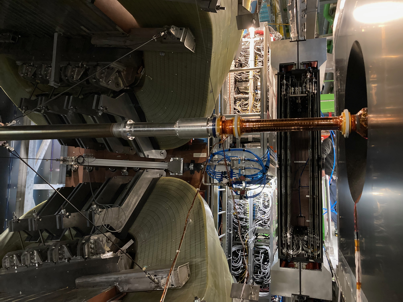
The proton beams started to circulate at the LHC on March 28th. The first collisions of a few bunches of protons took place on April 6th. These protons currently have 450GeV, the energy with which they are injected into the LHC, over the next period the beam energy will ramp-up to 6.8TeV. Follow the progress of LHC and LHCb commissioning and data taking at the LHCb Experiment Twitter.
The VELO modules are operated under vacuum in a volume separated from the LHC vacuum by an ultra-thin aluminum shield called the “RF box” between the LHC and detector volumnes. The thickness of this corrugated shield reaches less than two tenths of a millimetre in the central region in order to minimize interactions with the particles emerging from proton-proton collisions. During the end-of-year technical stop the volume containing the VELO modules and the LHC vacuum were filled with ultra pure Neon. A sophisticated pressure balancing system was operated in order to limit pressure differences between the two volumes to +2/-5 mbar. On January 10th, following a hardware component failure, this system functioned improperly, resulting in the pressure difference moving beyond the proper limits, and the RF boxes were accidentally deformed.
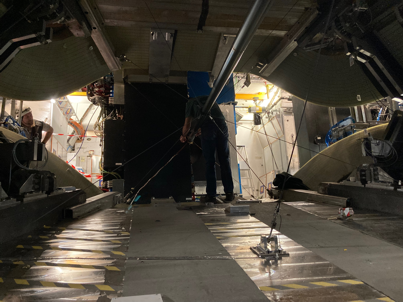
The VELO detector is divided into two halves which approach the proton-proton collision point as close as 5.1 mm during data taking (VELO IN position). Outside this period the two halves are retracted to the VELO OUT position, see “VELO closing news”. During the accident, the halves were located in the OUT position, and the VELO modules themselves were not affected. However the RF boxes are mechanically linked to the VELO and a change in their shape affects the degree to which the VELO sensors can be moved and centered around the colliding beams. In the near future, at sufficiently high rate of proton-proton collisions, the VELO detector itself will be used to image the deformed RF boxes, as it is able to measure with precision the position of the interaction in the material of the boxes of particles emerging from the proton-proton collisions. This 3D reconstruction will allow the VELO team to determine how close the VELO modules will be able to approach the LHC beams during 2023 data taking period. To allow LHCb to attain its nominal physics reach, the RF boxes will have to be replaced. In order to minimise the impact of this operation on the other LHC experiments, the LHCb collaboration will perform this replacement at the end of year shutdown.
Fifteen years after the first full collaboration meeting, and nine years after construction was approved, the installation of the LHCb Upgrade I is complete! We are looking forward to the operation of this second era experiment and excited to see what discoveries may await.

